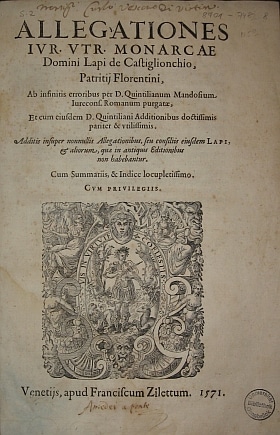The Ius-Commune-Bibliothek was acquired as a complete collection from the scholarly antiquarian bookseller Keip for a million deutschmarks and established by the Universität Osnabrück in 1991. It was based around a scholarly library that Keip had purchased in northern Italy and systematically supplemented from his existing stock. The entire collection was then put up for sale in 1989/1990 as the Ius-Commune-Bibliothek.
The Ius-Commune-Bibliothek comprises around 1,200 titles in 900 volumes. As a complete legal collection, it offers a virtually unique documentation of the development of jurisprudence in mainland Europe from the 13th through to the late 18th century. As its name indicates, the main focus of the collection is Roman Catholic common canon law, known as ius commune. This branch of law evolved out of the reception of legal sources dating from late antiquity and remained in effect until the early 19th century. Apart from several extremely old printed works, the oldest of which are an early printed book known as an incunabulum, a reform to Nuremberg’s municipal laws dating from 1484 that was printed by Anton Koberger and fourteen post-incunabula, the majority of the collection dates from the period 1540 to 1600 and from the years after 1660. The most recent printed work is from 1802.
Among the older legal sources are various editions of Corpus Iuris Civilis and Corpus Iuris Canonici as well as Codex Theodosianus (Lyon 1665), Friedrich Lindenbrog’s Codex legum antiquarum (Frankfurt 1613) and numerous editions of the Sachsenspiegel. The scholarly analysis of these legal sources is documented in works such as Glossa ordinaria by Franciscus Accursius (Venice 1583–84) and Azo’s summae (Venice 1584). The collection of medieval commentaries, such as those by Bartolus de Saxoferrato and Baldus de Ubaldis, Albericus de Rosate, Franciscus de Accoltis and Ludwig Pontanus, is very extensive. It is possible to trace how canon law increasingly became informed by scholarship in the works of Franciscus Zabarella, Antonius de Butrio, Petrus de Ancherano, Filippo Decio and Johannes Monachus and, in the late Middle Ages, in the commentaries on decretals by Nicolò de’ Tudeschi (Venice 1588), who was known as Panormitanus.
The representatives of the ‘French school’, who were labelled the ‘Elegant Jurists’, shaped the emergence of modern jurisprudence; they were later followed by leading figures of the Dutch school. Names worth mentioning here are Barnabé Brisson, Jacques Cujas, Franciscus Duarenus, Hugo Donellus, Johannes Faber, Franciscus Hotman and Pierre Loriot representing Elegant Jurisprudence, with Cornelius van Bynkershoek, Arnold Vinnius, Johann Voet und Gerard Noodt as members of the Dutch school. The evolution of German common law jurisprudence can be traced through key works by the jurists of usus modernus pandectarum: Johannes Brunnemann, David Mevius and Georg Adam Struve through to Augustin Leyser and his famous eleven-volume Meditationum ad Pandectas (Leipzig, Braunschweig and Wolfenbüttel 1761–1786). It is also worth mentioning German procedural law, which developed under the influence of canon law and is associated with works by authors such as Benedikt Carpzov (Processus iuris, Leipzig 1708) and Justus Henning Böhmer (Doctrina de actionibus, Frankfurt am Main 1756). More on commercial law and constitutional law can be found, for example, in the works of Hermann Conring and Philipp Knipschildt.
The collections of consilia and decisions form a large section. There are collected consilia from around fifty Italian, Spanish, French and German jurists, legists and canonists. The development of ius commune can be traced via collections of rulings by courts such as the Leipzig Schöffenstuhl (lay court) – in various works by Benedikt Carpzov – and the Obertribunal (supreme court) in Wismar, in the collection of decisions by David Mevius (Frankfurt and Stralsund 1675). Finally, the Ius-Commune-Bibliothek holds over 12,000 decisions by the Rota Romana (the highest appellate tribunal of the Catholic Church).
Although these holdings are highly important in the history of jurisprudence, they had hitherto been only inadequately catalogued. A one-volume alphabetical catalogue was the only available resource for researchers, and that could only be accessed locally. In order to make the collection accessible to a broader scholarly audience outside the region too, the printed works were catalogued at the Herzog August Bibliothek’s Kompetenzzentrum Alte Drucke (Competence Centre for Old Printed Works) in accordance with the strict rules established by the old printed works special interest group of the Gemeinsamer Bibliothek’s Verbund (Common Library Network, GBV). Key pages, especially the front covers, were digitised and added to the work’s catalogue entry. These printed works are now available to anyone who is interested, presenting a textbook example of how research should ideally be conducted. They can be accessed via the computer catalogue of Osnabrück university library, the GBV, and now also via the Karlsruher Virtueller Katalog; the process has led to significant treasures from Lower Saxony being uncovered. The cataloguing work in Wolfenbüttel was financed by a generous donation to Universität Osnabrück from Klosterkammer Niedersachsen.
A search link in the Osnabrück university library catalogue provides information on the current state of the cataloguing process.
